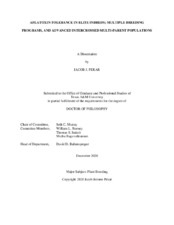| dc.contributor.advisor | Murray, Seth C | |
| dc.creator | Pekar, Jacob Jerome | |
| dc.date.accessioned | 2021-04-26T22:37:23Z | |
| dc.date.available | 2022-12-01T08:18:18Z | |
| dc.date.created | 2020-12 | |
| dc.date.issued | 2020-08-18 | |
| dc.date.submitted | December 2020 | |
| dc.identifier.uri | https://hdl.handle.net/1969.1/192686 | |
| dc.description.abstract | Aflatoxins contaminating our food supply in preharvest maize (aka corn, Zea mays L.) can cause serious illnesses such as: liver damage, intestinal bleeding, and even death; produced naturally by Aspergillus flavus Link:Fr, aflatoxins typically contaminate food supplies in countries without appropriate infrastructure.
Maize germplasm has and should continue to be developed and identified that can tolerate or completely resist the accumulation of aflatoxin. Evaluation of elite private and public inbred and hybrid combinations along with evaluating the most critical agronomic applications is essential to help in inhibiting accumulation. Using genetic markers to help increase the efficiency in selecting and pyramiding known QTL and SNP associations into elite germplasm is also an important component in the integrated pest management to decrease aflatoxin. Using all these avenues simultaneously could help in eliminate accumulation if they work synergistically.
This study first created a common garden in which we evaluated released and pre-released public inbred lines, along with important expired Plant Variety Protection (ex-PVP) commercial lines. The best of these lines will be useful in future population development or in direct hybrid combinations. Several synthetic populations were developed using several inbred lines from multiple private and public sources. These populations were used in pyramiding known SNP’s into a synthetic population which could then be used to confirm and utilize the know associated SNP. These synthetic populations were also evaluated on how certain germplasm interacts under stress and atoxigenic applications and how this germplasm tolerates aflatoxin accumulation.
Seven existing inbred lines had consistently high yield and low aflatoxin accumulation as desired. Two synthetic populations consisting of four and eight parents were developed, advanced into breeding populations and 1215 lines were selected which are currently being evaluated. Investigation into synergistic interactions between agronomic management x atoxigenic x genotype have concluded that genotypes can have better tolerance if coupled with appropriate management strategies.
This research will help in future breeding population creation along with developing insights into using multiple means to decrease or possibly eradicate aflatoxin accumulation in producers’ fields. | en |
| dc.format.mimetype | application/pdf | |
| dc.language.iso | en | |
| dc.subject | Aflatoxin | en |
| dc.subject | Aspergillus flavus | en |
| dc.subject | Plant Breeding | en |
| dc.title | AFLATOXIN TOLERANCE IN ELITE INBREDS; MULTIPLE BREEDING PROGRAMS, AND ADVANCED INTERCROSSED MULTI-PARENT POPULATIONS | en |
| dc.type | Thesis | en |
| thesis.degree.department | Soil and Crop Sciences | en |
| thesis.degree.discipline | Plant Breeding | en |
| thesis.degree.grantor | Texas A&M University | en |
| thesis.degree.name | Doctor of Philosophy | en |
| thesis.degree.level | Doctoral | en |
| dc.contributor.committeeMember | Rooney, William | |
| dc.contributor.committeeMember | Isakeit, Thomas | |
| dc.contributor.committeeMember | bagavathiannan, Muthu | |
| dc.type.material | text | en |
| dc.date.updated | 2021-04-26T22:37:24Z | |
| local.embargo.terms | 2022-12-01 | |
| local.etdauthor.orcid | 0000-0002-4559-248X | |


